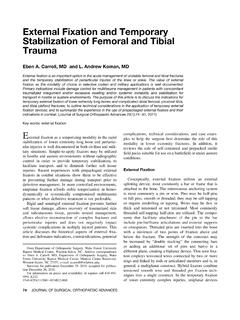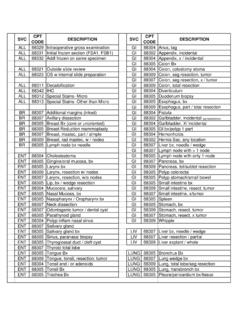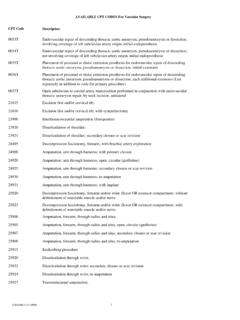Transcription of Lower Extremity Combat-Related Amputations
1 Lower Extremity combat -RelatedAmputationsLT Scott M. Tintle, MD,1 LCDR Jonathan Agner Forsberg, MD,1,2 CDR John J. Keeling,MD,1,2 LTC Scott B. Shawen, MD,1,2and MAJ Benjamin Kyle Potter, MD1,2 Since the onset of combat activity in Iraq and Afghanistan, there have been over 1100 major limbamputations among United States service members. With a sustained military presence in the MiddleEast, continued severe Lower Extremity trauma is inevitable. For this reason, combat surgeons mustunderstand the various amputation levels as well as the anatomic and technical details that enable anoptimal functional outcome. These Amputations are unique and usually result from blast mechanismsand are complicated by broad zones of injury with severe contamination and ongoing infection. Thecombat servicemen are young, previously healthy, and have the promising potential to rehabilitate tovery high levels of activity. Therefore, every practical effort should be made to perform sound initial anddefinitive trauma- related Amputations so that these casualties may return to their highest possible levelof function.
2 ( Journal of Surgical Orthopaedic Advances 19(1):35 43, 2010)Key words: amputation, combat trauma, residual limb, war woundsSince the onset of combat activity in Iraq andAfghanistan, there have been over 1100 major limbamputations among United States servicemen (1). With asustained military presence in the Middle East, continuedsevere Lower Extremity trauma is inevitable. For thisreason, combat surgeons must understand the variousamputation levels as well as the anatomic and technicaldetails that enable an optimal functional trauma- related Amputations are unique. Theyare usually the result of a blast mechanism and are compli-cated by broad zones of injury with severe contamina-tion and ongoing overt or latent infection. Other limbinjuries, systemic illness, and a delay to definitive carefor intercontinental flight complicate the care of theseamputees. These patients differ significantly from themore common elderly, dysvascular amputee population;they are generally younger and previously healthy andFrom1 Integrated Department of Orthopaedics and Rehabilitation,Walter Reed National Military Medical Center, Bethesda, MD;2 Department of Surgery, Uniformed Services University of HealthSciences, Bethesda, MD.
3 Address correspondence to: MAJ BenjaminK. Potter, MD, Integrated Department of Orthopaedics and Rehabilita-tion, Walter Reed Army Medical Center, 6900 Georgia Avenue NW,Bldg 2 Heaton Pavilion, Clinic 5A Orthopaedics, Washington,DC 20307; e-mail: views expressed in this article are those of the authors and do notnecessarily reflect the official policy or position of the Department of theNavy, Army, Department of Defense, or the United States for publication September 10, 2009; accepted for publica-tion September 28, information on prices and availability of reprints call 410-494-4994 $ 2010 by the Southern Orthopaedic Associationhave the promising potential to rehabilitate to very highlevels of activity (2).Therefore, every practical effort should be made toperform sound initial and definitive trauma- related ampu-tations so that these casualties may return to their highestpossible level of function. Adherence to established ampu-tation principles at each anatomic level can dramaticallyaffect the outcome and ultimate function of the amputee(3).
4 Long-term follow-up of these patients should besought to ensure that the residual limb continues to becapable of tolerating prolonged prosthetic wear at a high-demand Surgical GoalsThe initial surgical goal in the treatment of a patientwith a severe Lower Extremity combat injury is the thor-ough debridement of all contaminated wounds. All devi-talized muscle, skin, and bone must be excised during theearly surgical treatments in theater. Conversely, any andall viable muscle and fasciocutaneous tissue should besaved for possible use in the definitive soft tissue recon-struction. There is essentially no indication at this time toperform a guillotine amputation. This is an antiquatedtechnique which leaves no soft tissue coverage to maintainthe amputation at that length or level (Fig. 1).Soft Tissue ManagementProper management of the soft tissue envelope is crit-ical. The best predictor of the timing of definitive closure,VOLUME 19, NUMBER 1, SPRING 201035 FIGURE 1 Guillotine amputation with no soft tissue coverageavailable.
5 Patient will need revision to a more proximal limb length, and prolonged prosthetic use is the pres-ence of adequately robust soft tissue coverage. Myofascialand myoplasty closures are frequently used in the dysvas-cular and civilian trauma populations (4 7). These tech-niques, however, should serve only as secondary measuresin most Amputations and should virtually never be usedas the sole form of muscle stabilization in combat -relatedamputations (Fig. 2).Alternatively, myodesis is the preferred technique ofsoft tissue stabilization following trauma- related ampu-tation (8, 9). Myodesis is performed via suturing themuscular fascia to the end of the bone either throughdrill holes or directly sutured to the periosteum. Thisrestores the physiologic muscle tension, secures the deepsoft tissue padding, and prevents instability of the muscleunit. Myoplasty and myofascial closure may then be usedto augment the primary myodesis or myodeses.
6 Tenodesisis also an acceptable form of muscle stabilization at appro-priate amputation of NervesSymptomatic neuromata accompany 0% 25% of majorlimb Amputations and remain a frequent indication forreoperation (2, 10, 11). Stimuli such as stretching, pres-sure, vascular pulsation, or other irritation to the terminalneuroma bulb can be painful and often limits prosthesiswear. Multiple techniques have been developed in anattempt to decrease the risk of a symptomatic neuromaformation, but no method has convincingly demonstratedany improved outcome over a carefully performed tractionneurectomy with burying of the cut nerve end deep in theproximal soft tissues. A traction neurectomy places theneuroma away from the region of the definitive closureABFIGURE 2(A) Transfemoral amputation relaxed with a normal-appearing residual limb. (B) The same patient with active musclecontraction revealing an unstable quadriceps-hamstring scarring as well as the ligated vessels.
7 It is recom-mended for all named and other grossly visible nervesof the Lower Extremity at the various amputation performing a proximal transfemoral amputation,the sciatic nerve may require ligation prior to transec-tion to avoid bleeding from the substantive vaso nervosum(Fig. 3).An association between acute postoperative pain withchronic amputation- related pain has been studied andidentified. Patients who report the highest acute phantomlimbpainaremorelikelytohavephanto mlimbpainat6 and 12 months following surgery (12). For this reason,attempts have been made to reduce the acute postopera-tive pain experienced by amputees. While the long-termpositive impact of these techniques is debated, the short-term benefits of anesthetic intervention include increasedpatient comfort and a decreased narcotic requirement andmay allow for slightly earlier mobilization. Current anes-thesia guidelines continue to focus on methods to preventcentral neuroplastic changes from occurring through the36 JOURNAL OF SURGICAL ORTHOPAEDIC ADVANCESFIGURE 3 Transfemoral amputee with a symptomatic sciaticneuroma at revision surgery.
8 The nerve had been incorporatedinto the patient s hamstring myodesis and was anchored to themost distal aspect of his residual limb immediately adjacent to hisfemoral bone of preventive multimodal analgesic techniques toinclude nonsteroidal anti-inflammatory drugs, local anes-thetic nerve sheath injections, alpha-2 agonists, ketamine,opiods, preemptive epidurals, and regional nerve blocks(13).Level of AmputationThere is an increasing oxygen cost of ambulation as thesite of amputation moves to more proximal levels (14). Inan attempt to conserve energy, the average walking speedof an amputee self-adjusts to maintain a similar overalloxygen consumption to control patients without limb loss(15). For this reason, better outcomes are usually asso-ciated with longer residual limbs. However, this dictumoften does not hold true in cases of severe foot and ankletrauma when a transtibial amputation is often indicatedover a more distal foot or ankle amputation because ofbetter prosthetic fit and component combat trauma- related Amputations , the level ofthe most significant soft tissue injury usually determinesthe level of the amputation.
9 When determining the finallevel of limb length and closure, the following tenets ofPinzur should be observed (16).1. Optimal residual limb length without osseous promi-nences should be Reasonable function in the joint proximal to the levelof the amputation should be present in order to enhanceprosthetic A durable soft tissue envelope should be achieved anda full-thickness myocutaneous flap to cushion areas ofhigh pressure and shear is of LengthCombat trauma- related Amputations are usuallyperformed within the zone of injury. The Lower ExtremityAssessment Project (LEAP) study authors noted that 17of 19 knee disarticulations were performed through thezone of injury and that of the total study patientshad atypical flap coverage of the residual limb in theirseries (17). This atypical coverage within the zone ofinjury is the rule rather than the exception with Combat-Related Amputations and, despite the LEAP study findingsto the contrary, it is associated with a substantial increasein wound complications and heterotopic ossfication in thecombat wounded (18).
10 Multiple methods of preserving amputation length withcreative soft tissue coverage have been developed(19 28). Split-thickness skin grafting is the simplest mech-anism to preserve length when robust muscle coverageis present. Soft tissue expanders may also be used inconjunction with split-thickness skin grafting in order toachieve early, provisional closure and a delayed, durablecoverage at a later date (29, 30). Finally, more complex,pedicled or free tissue transfer can be used to preservelimb length with good success when indicated (20, 31).These length-preserving procedures are, however, asso-ciated with delayed prosthetic fitting and frequent revi-sion surgery (28, 32). They are most commonly indicatedaround the knee to maintain a transtibial level of , Chopart, and Syme DisarticulationsAmputations through the foot and ankle can be consid-ered when a patient has sustained severe forefoot traumawith sparing of the hindfoot plantar skin and soft potential benefits of these levels are the long leverarm, an ideal cosmetic appearance of the foot amputa-tions, and the potential ability to continue to bear weightand walk for short distances without the use of a prosthesis(3, 33).







